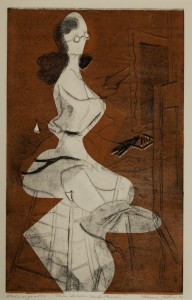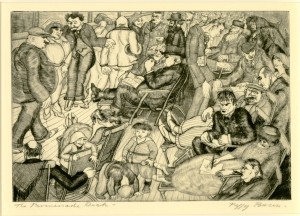
The Hillstrom Museum is now open, showcasing a new exhibit that features female-empowering artists, Minna Citron and Peggy Bacon. The exhibit opened on Feb. 17 and will be displayed until April 17.
The exhibit opening commenced with a reception featuring Minna Citron’s own granddaughter and student, Christiane H. Citron. The gallery features Citron’s collection, The Uncharted Course from Realism to Abstraction and Bacon’s collection, Keeping the Realist Course. On Monday, March 3 at 7:30 p.m., Associate Professor of Art History and Curator of the Juniata College Museum of Art Dr. Jennifer L. Streb will give a gallery talk on her doctoral dissertation of Citron.
Both Citron (1896-1991) and Bacon (1895-1987) lived during the same era and were very close in age. Although the two artists were not close friends, they knew of each other and had studied under some of the same professors at the Art Students League of New York. Their works reflect a similar style, originating from the styles of their shared mentors.
Citron was known for being an evolving abstract expressionist and a feminist. Classified as a painter and graphic artist, she also experimented with different mediums.
Citron studied at the Brooklyn Institute for Arts and Sciences in New York City, and the Art Students League. She later became employed by the Work Projects Administration Federal Art project, where she taught painting for a few years, and then traveled to Tennessee to paint murals.
Citron was best known for her social and urban realist images of New York City, and especially the lives of women. She strongly opposed conventional societal roles of women during that period, and pushed for individual expression.
Unlike fellow students in the Art Students League, Citron completely shifted her style from realism to abstraction in the early 1940s. Two self-portrait sketches displayed in the Hillstrom show this drastic change. The earlier piece is a black-and-white, realistic and accurately-proportioned woman sitting at her easel. The second piece, drawn 15 years later, shows the same painting, but in color and loosely drawn to reveal the slight shape of a woman. In response to her change in style, Citron explained that “something was lacking, and I decided to break away from the representational drawing to seek more dynamic creative expression in line, form, texture, and, above all, color.”
Peggy Bacon was a leading New York satirist, famous for her witty caricatures of celebrities, political figures, and artists. She excelled in sketching and printmaking, wrote and illustrated numerous children’s books, and published poetry and novels.

She studied at the League from 1915-1920 under teachers George Bellows, Kenneth Hayes Miller, and John Sloan. Bacon ended up becoming a teacher at the League later on in her life. She said she was “as much of a product of the League as it is possible to be.” And indeed, stylistically, Bacon resembled her mentors.
Bacon’s interest in sketching led her to become a famous caricaturist. She was hired in 1934 by The New Republic magazine in Washington D.C. to make satirical images of politicians. She eventually became overwhelmed by all the requests, and left the position to experiment with painting.
In 1953, she received the Edgar Allen Poe Award for Best First Novel from the Mystery Writers of America for her mystery, The Inward Eye. Over the course of her life, Bacon became a very decorated artist and writer. She was awarded the American Academy of Arts and Letters’ Gold Medal, in recognition of her “long and impressive career as a graphic artist and illustrator,” and her work was displayed at the Smithsonian American Art Museum, the first time a living female artist had been given the honor.
This month’s exhibit in the Hillstrom features art that will delight all audiences with Citron and Bacon’s beautiful depictions of life in New York and its intriguing faces, the stunning color, contrast and creativity, and the two women’s immense and inspirational artsmanship.